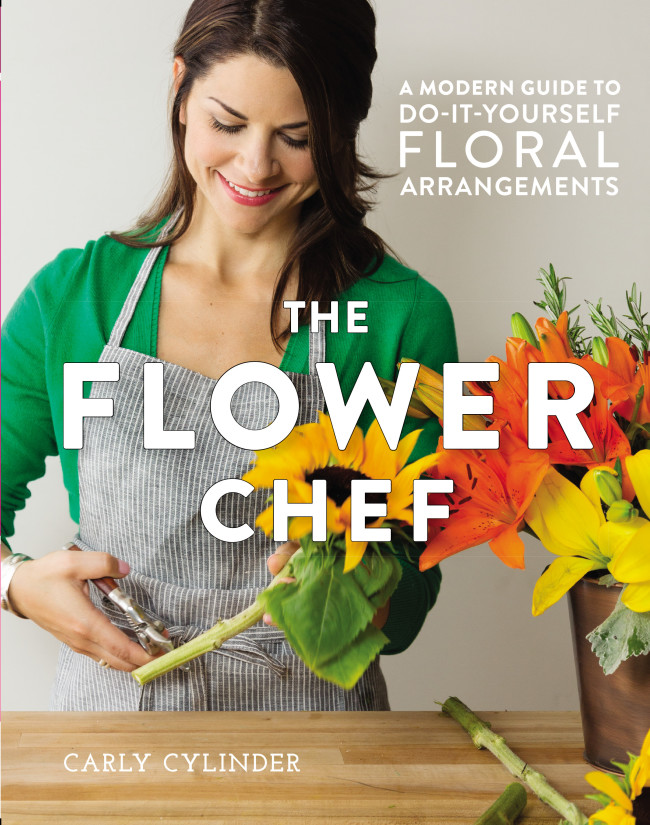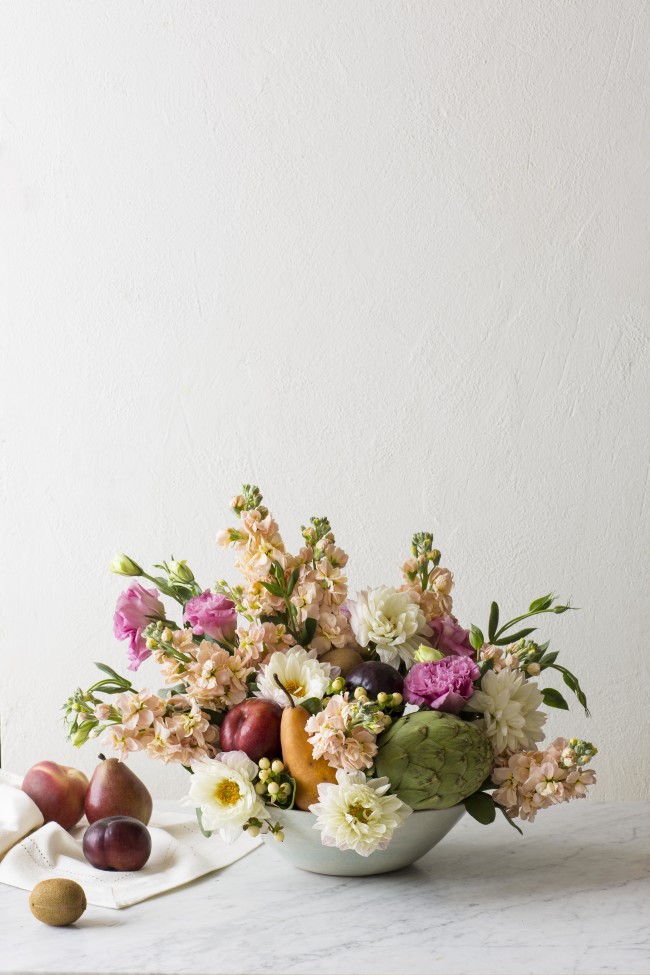
I’ve been looking for a good excuse to commission and wear clothing made of fruit, veg, and flowers for years, and my dream dress would feature an ombre effect made with savoy cabbage and lacinato kale (cabbage and kale sounds totally sexy, right?). So I am totally jealous of Carly Cylinder who not only was able to find the perfect event to wear a self-designed flower skirt, but she was able to make it herself – for her own book launch party.
Carly is a bi-coastal flower designer whose work is often featured in fashion shoots. Her new book, The Flower Chef, helps anyone to create similarly beautiful high-fashion floral designs. As part of her book launch, she shared with me some of her tips for arranging flowers and gathering inspiration, as well as one of her official ‘flower recipes’.
As we head into garden season, I am excited to experiment with the inevitable surplus my garden always produces. Her still-life inspired centerpiece arrangement recipe is a great guide for combining vegetables with flowers.
Q.
How would you define your style?
A.
I used to be all about doing tight, geometric designs, but lately have been influenced by rustic and foraged styles – whether I like it or not. So now I’d say it’s a blend of rustic and modern; rustic-modern.
Q.
Do you have any favorite or sentimental plants or flowers? Why are they a favorite?
A.
My favorite flowers are sweet peas. When I first saw them, I was entranced by their smell and loved their delicate petals. I love them arranged alone by themselves– so simple and beautiful. I also love hyacinths because they bloom beautifully and just make me happy!
Q.
What is your earliest or favorite gardening or flower-related memory?
A.
I didn’t know anything about flowers until my early twenties, but from childhood, I remember being fascinated by dandelions. We had many growing on our lawn in Pennsylvania, and I’d love to pluck honeysuckles from the trees.
Q.
What are three cardinal design rules (from your design field) that you think also apply to outdoor projects?
A.
1) Don’t overthink things. When you create quickly and intuitively, you usually get a more beautiful, unique, and organic design.
2) Have balance. Things can be asymmetrical and often look better that way, but there should be a balance to what you’re doing so that color or texture has a flow and makes sense.
3) Don’t listen to other people. It’s much better to follow what excites you than to try to copy a trend. Doing so gets tiresome and boring!
Q.
What do you do to find inspiration?
A.
I listen to music on a walk or bike ride to clear my mind when I’m in LA. In NYC, I like going to museums because there are so many, and they’re affordable. I love watching documentaries on all sorts of creatives because it’s inspiring to see another person carve their own path.
Q.
Best Garden or Design Advice Ever (Given or Received)?
A.
It’s not what you’re using; it’s how you use it. A designer at a flower shop told me that when I was working there as a sales girl, and that made a lot of sense to me. She’d create masterpieces out of mums and leftovers. That really stuck with me.
Q.
Favorite Things (pretend you are Oprah!)?
A.
This is hard! 1) I couldn’t live without Kiehl’s Calendula Toner. I had bad skin and acne throughout my entire twenties, and this is the one product that helped keep the dirt off my face and skin clean.
2) I love the book Drink This – Wine Made Simple because it helped me understand wine in a simple way.
3) Clear floral vase tape is the one thing I always say you need that there isn’t a substitution for.
STILL-LIFE CENTERPIECE
This arrangement reminds me of a still-life painting because of the muted color palette and the addition of fruits and vegetables. Charming, with a dash of whimsy, this would be perfect as the centerpiece for a family gathering or holiday dinner. Feel free to use up your older produce—just make sure it’s not too soft since you don’t want it to turn to mush or rot. Add in the fruit last, using wood floral picks. A variety of flowers is good for this arrangement, especially wildflowers. Feel free to brighten up the palette with kiwis, apricots, and even limes.
PREP TIME: 15 minutes COOK TIME: 25 minutes
SEASON: Spring/Summer/Fall
DIFFICULTY: 3
COST: $$$-$$$$
INGREDIENTS:
4 to 5 pieces of produce (artichokes, plums, kiwis)
1 bunch of white veronica or heather
Bunches of stock (1-2 in yellow, peach, pink, or white)
1 bunch of pink lisianthus or roses (10 to 12 stems)
3-5 pink, white, or peach dahlias
1 bunch of cream or green hypericum
Blocks of floral foam (depending on bowl size)
Wooden green floral picks (or any wood picks such as kebab sticks)
Serving bowl
Optional: thick green floral tape
1. Soak the floral foam, then cut the foam so that it fits snugly in the bowl. If you’re using a very low bowl and it seems like the foam is going to fall out, stretch multiple strips of the floral tape around the bowl and the foam, crisscrossing as you go so that the strips make a cross or a star shape over the top of the foam to hold it in.
2. Cut or break the floral picks so that they are about 6″ long. It’s OK if the end is jagged; that will make it easier to pierce the fruit or vegetable. Insert the pointy end of one stick about an inch deep into a piece of produce; spearing the produce anywhere is fine, as long as it’s secure. (Note: Artichokes are the exception and should be speared 2″ deep directly into the stems.) Do this with each piece of fruit and vegetable you’re using.
3. Prepare the flowers and then separate them by type. If you like, you can keep some foliage at the top.
4. Cut a few stems of veronica (or heather) and stock to about 8″ to 10″ long. Cut another few stems of the same types of flowers to about 4″ to 5″ long.
5. Using the veronica (or heather) and stock, form an asymmetrical V shape as the starting outline for the arrangement (see photo at right). Insert the taller veronica and stock, angled moderately outward, on the left side. Insert the shorter veronica and stock on the right side, angled outward almost horizontally. If possible, bend the shorter pieces a bit downward, being careful not to snap the stems. The arrangement should be asymmetrical overall.
6. A very open V shape will start to form. Cut a few stems of the lisianthus, or roses, to the same height as the taller veronica and place them nearby, following the rough outline that has developed. Cut a few stems of the lisianthus, or roses, to the same height as the shorter veronica and place them near those stems.
7. Cut the dahlias to about 6″ to 8″ long and place them evenly throughout the entire arrangement, some at the midway height between the taller and shorter flowers, creating a smooth, gradual line. You can place a taller stem toward the left side. Cut half at 8″ and place at the top of the V, then cut half at 6″ and put at the bottom of the V.
8. Add in the hypericum and evenly distribute throughout. The flowers don’t have to be in a certain order or pattern; just make sure the colors are balanced.
9. Add in the rest of the stock and veronica to further define the V shape. Turn the vase and add flowers so that the arrangement looks full.
10. Add in the produce at the bottom half of the arrangement. Rotate the arrangement about one quarter-turn after each insertion to ensure that the fruit and vegetables are evenly distributed.
DESIGN TIP:
Create a matching side arrangement with leftover flowers or simply fill a pretty smaller bowl with leftover produce.
Images: Recipe excerpted from the book THE FLOWER CHEF by Carly Cylinder. Copyright © 2016 by Carly Cylinder. Reprinted with permission of Grand Central Life & Style. All rights reserved.
Related Posts:

+comments+